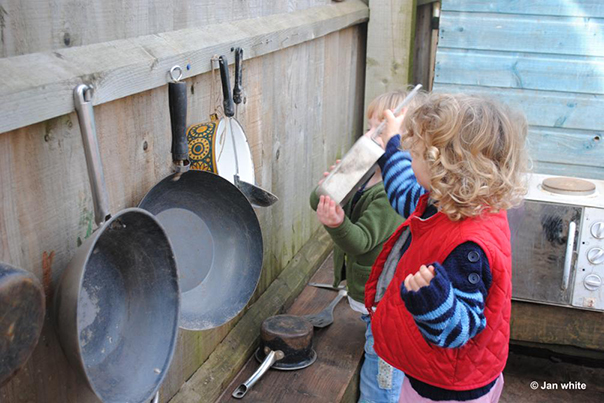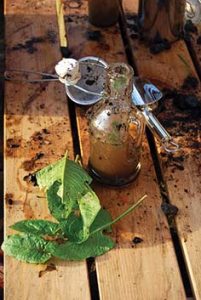 Guidelines for Creating a Mud Kitchen
Guidelines for Creating a Mud Kitchen
There is little more important in our physical world than earth and water and they are truly intriguing things, especially when they interact. Mixing soil, water and a range of other natural materials has a foundational role in early childhood which has deep importance and endless possibilities for well-being, development and learning. The breadth and depth of what these experiences offer young children is truly remarkable.
Mud kitchens provide something quite different to a soil digging patch, whilst also being much more easily managed. A mud kitchen includes elements of the much-loved domestic corner and cooking from indoor play, which are then hugely enriched through the special nature of being outside. Mud kitchens work well all year round, and need to be seen as a core element of continuous provision outside.
Mud kitchens do not need to be fancy or cost much. There is nothing to beat the simplicity and character of creating your own unique kitchen from scrounged, begged and discovered items. And remember, the best mud kitchens are made in collaboration with the children who will be using them.
Choose the Place
The kitchen needs a handy with ample supply of the basic materials of sand and/or mud. Offering both provides contrast in colour, texture and mixing behaviour – and many more possibilities for imaginations. Being situated near the sand area or mud patch may give the kitchen more context and meaning, but big pots of these basic materials will also be fine, preferably at floor level for ease of access.
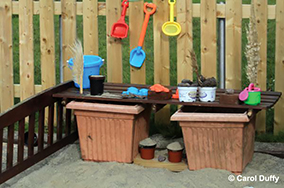 Mud kitchens that have walls, fences or other vertical surfaces on one or two sides then have potential for hanging pots and utensils on them or for installing shelving, making it feel more kitchen-like and better to use. A corner also creates room-like enclosure that feels cosy and safe, which research suggests is good at generating dramatic play in young children.
Mud kitchens that have walls, fences or other vertical surfaces on one or two sides then have potential for hanging pots and utensils on them or for installing shelving, making it feel more kitchen-like and better to use. A corner also creates room-like enclosure that feels cosy and safe, which research suggests is good at generating dramatic play in young children.
A water supply is essential, but it does not need to be in the kitchen or even close-by, as children love to fill containers both large and small to transport across to the kitchen for use. Make sure however that there are several types of collecting containers for this activity and an ample (preferably running) water source, such as an outdoor tap, water butt or a large container of water.
Plant material is also an important ingredient of a good mud kitchen. Lots of robust, pickable plants spread around the whole outdoor space are ideal.
Make the Space
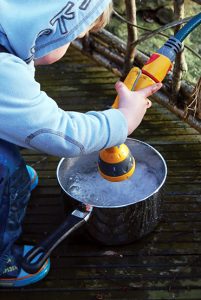 Kitchens can be all sizes, but the size will influence the feel of the place and, therefore, probably the kind of activity that takes place. Room for several children to work alongside or in collaboration seems important. Large, open-plan kitchens may well generate more boisterous themes and actions. A choice of both large and small nook-like kitchens would be ideal in a group setting.
Kitchens can be all sizes, but the size will influence the feel of the place and, therefore, probably the kind of activity that takes place. Room for several children to work alongside or in collaboration seems important. Large, open-plan kitchens may well generate more boisterous themes and actions. A choice of both large and small nook-like kitchens would be ideal in a group setting.
Enclosure from fences and walls or by installing low level boundaries such as wicker fencing (so that children can see over but the space feels enclosed by them) can create a good mud kitchen feel.
A roof is not necessary as this would prevent the elements being part of the stimulus and range of experiences.
Some kitchens that are in the middle of an open sand/digging area work fine too, but perhaps have less sense of being a special place.
In creating some sense of enclosure, it’s important not to separate the kitchen from the rest of the outdoor space. It needs to be easy to get in and out and to see in and out, and it needs to interact with whatever else is going on outdoors.
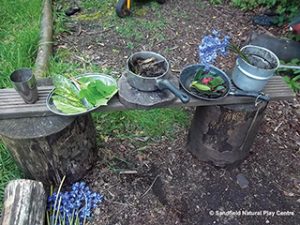 Working surfaces are a crucial element. These need to be at the right height for the children and to provide enough space to work at, with all the mess that creative kitchen work entails.
Working surfaces are a crucial element. These need to be at the right height for the children and to provide enough space to work at, with all the mess that creative kitchen work entails.
Shelving and cupboards add much to the feeling and functionality of the kitchen. It’s really helpful if each pot and utensil stands out by itself (compared to the jumble of a box full of stuff), and is easy to get at.
Hooks on walls or the front edge of shelves (beware that hooks are not at eye-poking height).
Baskets to separate types of utensil can be useful.
Finally, consider where all the old mixed material is going to go after use!
Fit it Out
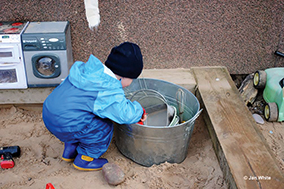 An old cupboard or two; a dresser is perfect!
An old cupboard or two; a dresser is perfect!- Work top with plenty of surface to work at.
- Something to be the cooker in pretend play (an old microwave can be very effective, having a very satisfying door to open and close, and buttons to push)
- Shelving above and behind the work surface, or a tall cupboard to one side.
- A good basic selection of pots and pans, jugs and funnels, bakeware etc. An interesting collection of common kitchen utensils.
- Plenty of bowls and containers, again a range of the common ones and a few special ones such as jelly moulds or ice-cube trays.
- Supplies of natural materials in small containers and/or jars (lids that stay attached are ideal as they do not get lost).
- Enhancements for suitable occasions, such as a selection of food colourings, essences, herbs and spices, chalk for grinding and mixing, and ‘special’ ingredients to add the final magical touches to potions and spells.
- A big washing up bowl, especially one sunk into the worktop, is very helpful as part of the play and for washing up afterwards.
Find what you need
The best mud kitchens, and those which have the most atmosphere and character, are made from found, gathered and donated items – especially when these come from the children’s own families. It’s important not to spend much money – what matters to children is that these things come from the real human world, to combine with the stuff of the real physical world.
Here are a few of the possibilities:
Hand washing is important after playing in this way, so routines and expectations must be agreed with the children, set up to work easily and adhered to, to embed hand-washing as habitual. The best first stage to this is to establish the routine that children wash up the pots they have used in a large bowl of warm, soapy water!
This content and photos are reproduced with permission from the MuddyFaces free resources. The document was written by Jan White (www.janwhitenaturalplay.wordpress.com) and produced by Muddyfaces www.muddyfaces.co.uk. Visit these sites for more great resources.


